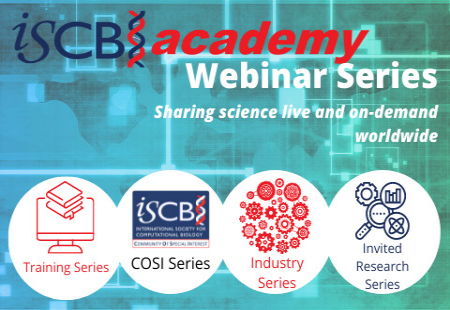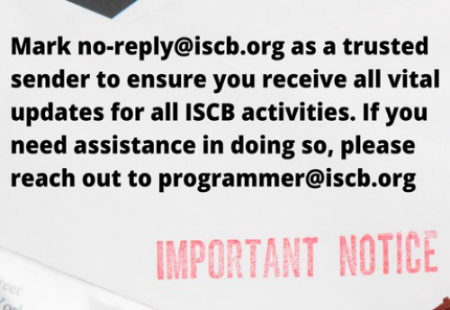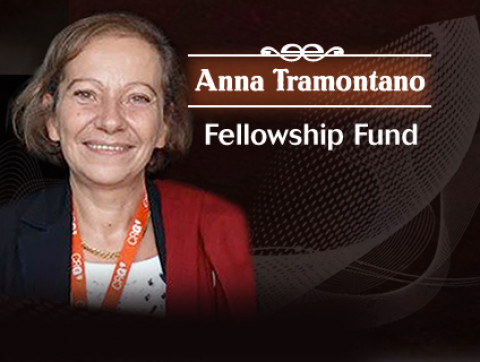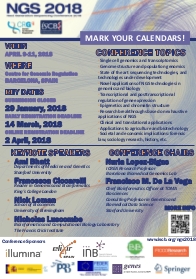| Submission # |
Title |
Author(s) |
| 1 |
Anti-inflammatory, immune-modulatory and antioxidant effects of date fruit (Phoenix dactylifera) extract in rats treated with AlCl3 |
Fawzia Alshubaily and Nadia Osman |
| 2 |
Diagnosis of Glioma Tumors Using Circulating Cell-Free DNA |
Vikrant Palande, Dorith Raviv-Shay and Milana Frenkel-Morgenstern |
| 3 |
Functional and Structutural analysis of the impact of the SNPs in Human Gene SCN8A, In Silion Approach |
Nosaiba Elkheir M. Ali, Elaf Ibrahim Osman, Rayan S Ali, Sahar E. E. Mohamed, Fedaa Fathalrahman M, Amin M. Ahmed, Sara Shamat, Sanad Abdalbage Mohammed Abdalsadeg Mohammed, Ashraf Osman Ibrahim and Mohamed A. I. Alfaki |
| 4 |
Comprehensive evaluation of de novo transcriptome assembly programs and their effects on differential gene expression analysis |
Sufang Wang, Hui Yang, Chen Zhang, Nu Zhang and Michael Gribskov |
| 5 |
Computational Analysis of Functional Coding/Noncoding Single Nucleotide Polymorphisms (SNPs/Indels) in Human NEUROG1 gene |
Shimaa Mahalah, Zhoor Hamid, Samah Ibrahim and Shazalia Babiker |
| 6 |
A comprehensive analysis of small non-coding RNAs in T-cell prolymphocytic leukemia samples |
Leticia G Leon, Fabiënne van Opstal, Steven C. Koetzier, Joyce Schilperoord-Vermeulen, Anton W. Langerak and Stefan J. Erkeland |
| 7 |
Pilot microbiome profiling of a pharmaceutical factory reveals influence of workers, water, and soil |
Amal Hamdy, Moamen El-Massry, Mona Kashef, Magdy Amin and Ramy Aziz |
| 8 |
Using MinION to assist de novo assembly of the Streptococcus agalactiae genome |
Tamara Hernández-Beeftink, Hector Rodríguez-Pérez, Ana Díaz-De-Usera, Rafaela González-Montelongo, José M Lorenzo-Salazar, Fabián Lorenzo-Díaz and Carlos Flores |
| 11 |
Whole genome sequence of Methicillin-resistant Staphylococcus aureus strain SO-1977 isolated from Sudan |
Sofia Ali |
| 13 |
Efficient population-scale variant analysis and prioritization with VAPr |
Adam Mark, Amanda Birmingham, Carlo Mazzafe, Guorong Xu and Kathleen Fisch |
| 16 |
Detection of signatures of translation and ribonucleoprotein particles in evolutionary conserved regions of long non-coding RNAs. |
Jorge Ruiz-Orera and M. Mar Albà |
| 18 |
Sequencing and annotation of resurrection plant H. rhodopensis cp and mt genomes. |
Zdravka Ivanova, Elena Apostolova, Gergana Zahmanova, Evelina Daskalova, Galina Yahubyan, Ivan Minkov and Vesselin Baev |
| 19 |
Clustering sRNA-seq data for plant miRNAs de novo annotation. |
George Minkov, Valentina Toneva, Ivan Minkov and Vesselin Baev |
| 22 |
Assessing the genomic diversity and selection footprints on dromedary camels using full genome sequencing and genotyping-by-sequence approaches |
Hussain Bahbahani, Hassan Musa, Eltahir Shuiep, Faisal Al Mathen and Olivier Hanotte |
| 23 |
A Novel Association between Lysyl Oxidase (LOX) Gene Polymorphisms and Intracranial Aneurysm in the Korean population |
Bong Jun Kim, Young Mi Kim, Jin Pyeong Jeon and Jae Jun Lee |
| 24 |
Using RNA-seq and Ribo-seq to understand de novo gene origination in yeast |
William Blevins, Xavier Messaguer, Jorge Ruiz-Orera, José Luis Villanueva-Cañas, Bernat Blasco-Moreno, Laura Aviñó-Esteban, Guillem Lopez-Grado Salinas, Lorena Espinar, Juana Díez, Lucas Carey and M. Mar Albà |
| 25 |
Inference of genomic spatial organization from single WGBS samples |
Emanuele Raineri, Francois Serra, Renee Beekman, Roser Vilarrasa-Blasi, Iñaki Martin-Subero, Marc Marti-Renom, Ivo Gut and Simon Heath |
| 26 |
Somatic Variant Calling Benchmarking |
Milan Domazet, Sanja Mijalkovic and Aleksandar Makragic |
| 27 |
High-throughput characterization of RNA function at single site resolution from mutational interference mapping experiments (MIME) |
Maureen Smith, Redmond Smyth, Roland Marquet and Max von Kleist |
| 28 |
Improving target sequence information via de novo assembly of RNA-Seq data from closely related species |
Julia Söllner, Germán Leparc, Matthias Zwick, Kay Nieselt and Eric Simon |
| 29 |
Identification of a single nucleotide insertion associated with antibiotic resistance in Burkholderia pseudomallei |
Véronique Sarilar, Charles Chapus, Marine Schnetterle, Olivier Gorgé, Aïda Boughammoura, Fabienne Neulat-Ripoll, Fabrice Biot and Thomas Poyot |
| 30 |
Comparison of orthology determination algorithms for RNA-seq phylogenetics |
Madison H Hansen and Ward C Wheeler |
| 31 |
Efficient large-scale whole genome alignment computation based on the SuperGenome |
André Hennig and Kay Nieselt |
| 32 |
A workflow for accurate neoantigen discovery using NGS data |
Ognjen Milicevic, Vladimir Kovacevic, Ana Mijalkovic Lazic, Nikola Skundric, Nevena Ilic Raicevic, Milica Kojicic and Jack Digiovanna |
| 33 |
Next-Generation Sequencing and Network Analysis of Mycobacterium tuberculosis |
Sridhar Hariharaputran |
| 34 |
Rabix Suite: open-source development project for creating and running computational workflows in Common Workflow Language |
Bogdan Gavrilovic |
| 35 |
Capturing changes in transcription factor activity with ATAC-Seq |
Ignacio Tripodi, Mary Ann Allen and Robin Dowell |
| 37 |
Homologous recombination deficiency detection in breast cancer using whole exome sequencing TCGA data |
Marko Petkovic, Aleksandra Stevovic, Gavrilo Andric and Stefan Stojanovic |
| 39 |
Identifying genomic regions susceptible to systematic sequencing error to improve variant detection |
Timothy Freeman, Dennis Wang and Jason Harris |
| 41 |
Simultaneous detection and accurate quantification of coding and non-coding RNAs using a single sequencing reaction |
Vincent Boivin, Gabrielle Deschamps-Francoeur, Sherif Abou Elela and Michelle Scott |
| 43 |
Phylogeny-guided genome assembly method for short nucleotide reads from deep sequencing of mixed microbial samples |
Guangchuang Yu, David Smith, Huachen Zhu, Yi Guan and Tommy Tsan-Yuk Lam |
| 46 |
Mining of RNA-seq libraries to compute cellular metabolic state |
Marcelo Rivas-Astroza and Raúl Conejeros |
| 47 |
Identification of micropeptides by characteristic splicing patterns in RNA-seq data |
Alexey Mironov, Olga Kalinina, Rory Johnson and Dmitri Pervouchine |
| 50 |
Identification of epigenomic features linked to 3D interactions using snapshots of chromatin social networks |
Kat Cheung, Vera Pancaldi, Inmaculada Hernandez-Lopez, Laura Castro, Alfonso Valencia, Manolis Papamichos-Chronakis, Lisa Prendergast and Daniel Rico |
| 51 |
FASH16S - Fast automated shell based running pipeline for 16S rRNA amplicon NGS data |
Balamuralikrishna Jayaprakash, Jussi Paananen, Tarja Pitkänen, Pirkka V. Kirjavainen and Martin Täubel |
| 54 |
Genomic locus-locus interaction networks to identify non-coding pathogenic mutations in immune disorders |
Maninder Heer, Sophie Hambleton and Daniel Rico |
| 57 |
METAGENOMIC STUDY OF ENTERIC VIROME IN PROBOSCIS MONKEY |
Kar Hon Ng, Tommy Tsan-Yuk Lam and Yee Ling Chong |
| 59 |
Premature termination codon containing transcripts comprise a significant fraction of mRNAs |
Anna Hakobyan and Maria Nikoghosyan |
| 60 |
NGS-based miRNA analysis with miRCarta and miRMaster |
Tobias Fehlmann, Christina Backes, Fabian Kern, Valentina Galata and Andreas Keller |
| 62 |
Variant annotation pipeline for the identification of splice site SNVs |
Susanne Kirchen, Dheeraj Bobbili and Patrick May |
| 64 |
Integrated analysis of microRNA and mRNA expression profiles in Pediatric Multiple Sclerosis |
Nicoletta Nuzziello, Arianna Consiglio, Flavio Licciulli, Marta Simone, Giorgio Grillo, Sabino Liuni, Maria Trojano and Maria Liguori |
| 66 |
Analysis of differential expression of human transmembrane proteins in tumour and normal samples |
Zsuzsanna Gergely and Gábor Tusnády |
| 67 |
Reference genome assessment from a population scale perspective: an accurate profile of variability and noise |
José Carbonell-Caballero, Alicia Amadoz, Roberto Alonso, Marta R. Hidalgo, Cankut Çubuk, David Conesa, Antonio López-Quílez and Joaquín Dopazo |
| 68 |
Nanopore sequencing on low-biomass microbiota samples: cpn60 UT, full length 16S rRNA gene and whole rrn operon |
Anna Cusco, Joaquim Viñes and Olga Francino |
| 69 |
Identification of PAX6-dependent regulatory network during endocrine pancreatic cells and enteroendocrine cells differentiation in zebrafish |
Arnaud Lavergne, Estefania Tarifeño and Bernard Peers |
| 70 |
DEVELOPMENT OF A TARGETED NEXT-GENERATION SEQUENCING PANEL FOR DETECTION OF TRANSLOCATIONS, CNAs AND MUTATIONS IN MATURE B CELL NEOPLASMS: COMPARISON WITH CONVENTIONAL GENETIC TECHNIQUES |
Andrea Gómez Llonín, Anna Puiggros, Benjamín Rodriguez-Santiago, Lara Nonell, Jairo Rodríguez, Heidi Mattlin, Maria Isabel Banchs, Marta Salido, Sílvia Beà, Anna Enjuanes, Mª José Larrayoz, Laura Blanco, Rosa Collado, Margarita Ortega, Esmeralda de La Banda, María Rodríguez-Rivera, Carme Melero, Xavier Calvo, Leonor Arenillas, Eva Gimeno, Blanca Sánchez, Antonio Salar, Lluís Armengol, Ana Ferrer, Lluís Colomo and Blanca Espinet |
| 71 |
Combining culture-based and culture-independent strategies to understand the gut microbiomes of azo dye-reducing fecal samples |
Sara Zahran, Marwa Ali-Tammam, Amal Emad Eldin, Ramy Aziz and Abdelgawad Hashem |
| 74 |
Have you met my new cousins? Fast and accurate pathogen detection in environmental samples |
János Juhász, Lőrinc S. Pongor, Attila Jády and Balázs Ligeti |
| 76 |
Sequencing and analysis of Argania spinosa Genome |
Nour El Houda Azza, Stacy Ciufo, Tatiana Tatusova, M. Gonzalo Claros, Abdelhamid El Mousadik and Hassan Ghazal |
| 78 |
Linkage disequilibrium maps to guide contig ordering in genome assembly |
Reuben Pengelly and Andrew Collins |
| 79 |
OneD: increasing reproducibility of Hi-C samples with abnormal karyotypes |
Enrique Vidal, François Le Dily, Javier Quilez, Ralph Stadhouders, Yasmina Cuartero, Thomas Graf, Marc A Marti-Renom, Miguel Beato and Guillaume J Filion |
| 80 |
Second generation molecular subgrouping of medulloblastoma: towards a working consensus of Group 3/4 subtypes |
Tanvi Sharma, Edward C. Shwalbe, Daniel Williamson, Volker Hovestadt, Lukas Chavez, Marcel Kool, Paul A. Northcott, Stefan M.Pfister and Steven C.Clifford |
| 81 |
Sequencing of CynD from Bacillus pumilus isolated in Peru revelated a intraspecies variable nucleotide sequences but conserved amino acid sequences. |
David Pabon, Roberto Pineda, Mauro Quiñones and Santiago Justo |
| 82 |
A new method to phase de novo mutations in trios |
Layal Yasin, Carolin Walter, Julia Taeubner, Martin Dugas, Arndt Borkhardt and Michaela Kuhlen |
| 84 |
nextPARS: Parallel probing of RNA structures in Illumina |
Ester Saus, Jesse Willis, Leszek P. Pryszcz, Ahmed Hafez, Carlos Llorens, Heinz Himmelbauer and Toni Gabaldón |
| 89 |
SNuPy an online platform that empowers genetic scientists to unravel disease‑causing variants from intricate genotype studies |
Sebastian Ginzel, Michael Gombert, Ute Fischer, Arndt Borkhardt and Ralf Thiele |
| 90 |
Pangenomics: efficient and scalable genome analysis |
Sandra Smit, Siavash Sheikhizadeh Anari, Eef Jonkheer and Dick de Ridder |
| 92 |
Gene prioritization, communality analysis, networking, and metabolic integrated pathway to better understand breast cancer pathogenesis (POSTER) |
Andrés López-Cortés, César Paz-Y-Miño, Alejandro Cabrera-Andrade, Santiago Guerrero, Stephen J Barigye, Cristian R Munteanu, Humberto González-Díaz, Alejandro Pazos-Sierra, Yunierkis Pérez-Castillo and Eduardo Tejera |
| 93 |
Pangenomic applications in plants and pathogens |
Eef Jonkheer, Sandra Smit, Theo van der Lee, Siavash Sheikhizadeh Anari and Dick de Ridder |
| 94 |
Identification of microRNAs as modulators of gene expression during sexual differentiation in fish under high-temperature effects. |
Javier Moraleda, Julien Bobe, Francesc Piferrer and Laia Ribas |
| 95 |
Length matters: Upgrading genome assemblies with Nanopore sequencing |
Tyler Alioto, Fernando Cruz, Jèssica Gómez Garrido, Pere Arús and Miodrag Grbic |
| 96 |
Benchmarking Project of Bisulfite Sequencing Workflows |
Pavlo Lutsik, Reka Toth, Christoph Plass and Yassen Assenov |
| 97 |
Scalable and Reproducible NGS Pipelines with epiCWL |
Kersten Breuer, Pavlo Lutsik, Yoann Pageaud, Reka Toth, Christoph Plass and Yassen Assenov |
| 98 |
A custom bioinformatics analysis pipeline for the stratification of admixed populations and prioritisation of rare single nucleotide variants |
Nada Salem, Ashraf Dallol, Adel Abuzenadeh, Emmanouil Dermitzakis and Hend Nour Eldin |
| 99 |
Brain gene expression response to pesticide exposure indicates effects on cognition. |
Yannick Wurm, Isaabel Fletcher, Thomas Joe Colgan, Andres Arce and Richard Gill |
| 100 |
Degenerative expansion of a young social chromosome supergene |
Eckart Stolle, Rodrigo Pracana and Yannick Wurm |
| 102 |
Whole Genome Sequencing to Track the Origin and Transmission of Tuberculosis in Low Prevalence Setting of Australia |
Sanjay S. Gautam, Micheál Mac Aogáin, Louise A. Cooley, Greg Haug, Janet A. Fyfe, Maria Globan, Ronan F. O’Toole |




















 Ami Bhatt
Ami Bhatt Francesca Ciccarelli
Francesca Ciccarelli Nick Loman
Nick Loman Nicholas Luscombe
Nicholas Luscombe




